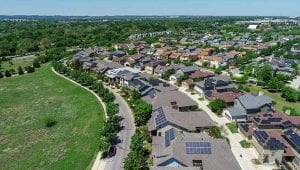Australia’s official economic forecaster has finally admitted that the cost of nuclear energy is more than double other clean energy alternatives, suggesting it would likely play no role in a decarbonised grid based around lowest costs.
The Australian Power Generation Technology Report – a 362-page collaborative effort from more than 40 organisations, including the CSIRO, ARENA, the federal government’s Department of Industry and Science and the Office of the Chief Economist – clearly shows that solar and wind will be the cheapest low carbon technologies in Australia.
It comes at a critical time, with the nuclear lobby, supported by existing coal generators, pushing nuclear generation heavily, on the basis of previous technology cost assessments that had unrealistically optimistic views of its costs.
But the APGT report has essentially ruled out nuclear power for the whole of Australia, revealing that the technology is becoming more and more prohibitively expensive, at around double the capital cost estimated three years ago – and double the cost of competing technologies.
The research – undertaken by the Electric Power Research Institute (EPRI), Worley Parsons in Australia and Ernst and Young, and peer reviewed by the Australian Government Bureau of Resource Research Economics (BREE) – has been used to provide “credible technology cost and performance data for 2015 to 2030.”
And one of the big take-aways from its findings is that the cost projections for nuclear have changed considerably from previous estimates – particularly the 2012 Australian Energy Technology Assessment (AETA) by BREE, which we described as “astonishing” at the time, given the real-world experience.
As you can see in the tables below, based on the levelised cost of energy (LCOE) – which is the the average cost of producing electricity from that technology over its entire life – nuclear is found to be more expensive than wind and five out of six solar technologies in 2015.

By 2030 (below), it is more expensive than everything. And this is the figure that counts, because it is an impossibility that nuclear could be built in Australia before that time. Some would suggest it would take another 10 years.

The cost inputs (of building new nuclear generation) go from roughly $4500/kW (AETA 2012) to $6000 (AETA 2013) to $9000/kW in today’s update.
As noted above, this is quite a revision. The 2012 AETA by BREE evaluated 40 utility-scale generation technologies including large nuclear plants and small modular reactors, and named the latter two among the six lowest-cost options by 2040.
Similarly, the eFuture study by CSIRO showed that the inclusion of nuclear power as an option caused wholesale prices to be 34-37 per cent lower, and led to a 53 per cent nuclear share in 2050.
In an updated report in 2014 – concluded after “consultation” with various industry sectors – AETA rectified its errors by lifting its estimates of the capital costs of nuclear by around 50 per cent. And we wondered how quickly the CSIRO would amend its own modeling.
Today, a spokesperson from the CSIRO said that “as the outlook for nuclear costs has deteriorated with each update, eFuture has accordingly decreased the role that nuclear can play in Australia’s electricity mix.”
As we said last year, getting the LCOE of different energy generation technologies right – or at least improving on previous efforts – is critical for Australia as it makes decisions about its energy future.
The findings of this new report are particularly salient in light of the current SA Royal Commission into nuclear power, especially considering many of the submissions made in favour of nuclear – like this one from the representatives of coal fired generators, and this one from the World Nuclear Association.
Both of these submissions relied on the previous cost estimates from BREE that suggested nuclear was much more cost effective than solar.
The WNA ignored the 2013 cost estimates, and used the 2012 estimates incorporated by the CSIRO to suggest that the inclusion of nuclear power would cause wholesale prices to be 34-37 per cent lower, and would lead to a 53 per cent nuclear share in 2050. The ESAA reached a similar conclusion on wholesale prices.
Both the nuclear and the coal industry lobbies have a shared advantage in slowing down the deployment of wind and solar, because it narrows and ultimately removes the need for large-scale centralised generation. The energy system of the future will be based around dispatch able generation.
The new report came one day after nuclear power was ruled out as a contributor to the future low-carbon electricity mix of South Australia by a government-commissioned advisory panel, which said it was too expensive.
The South Australian government embraced its recommendation to target net zero emissions by 2030, although held back on its suggestion of going 100 per cent renewable energy. Presumably it will await the outcome of the nuclear royal commission. Hopefully the commission looks at the new cost estimates, and does not rely on hopelessly out of date and optimistic cost estimates.










